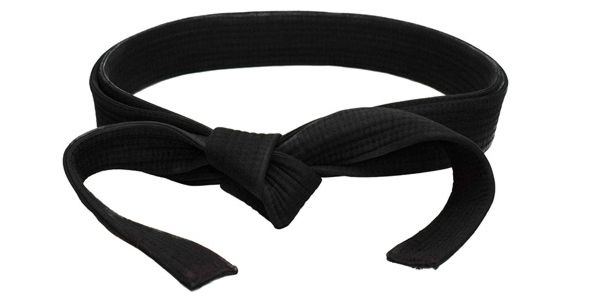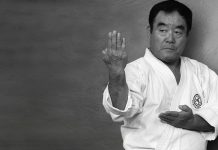A black belt is a piece of dyed white cotton, but we attribute many characteristics with the attainment of this object. Martial arts training is a never ending journey, with many layers and facets associated with the training.
The problem is that this training cycle is “front loaded,” meaning that there is a great deal of prerequisite knowledge and ability that must be gained in order to begin understanding the true nature of the martial arts. Once this knowledge is generally familiar, we are ready to be granted a “black belt.” (In Japan, budoka rarely speak of someone “being a black belt,” but rather, they say that someone is a yudansha —“a person with dan.” Dan means a “grade” or “rank,” and dan usually number from one to ten. Thus, most traditional budoka in Japan will rarely say, “I’m a black belt,” as this implies that they are equating themselves with a piece of cotton. Instead, they will usually state something like, “I’ve received a fifth dan in Shorin Ryu karate-do.” –H.E. Davey, Editor) These prerequisites fall into the physical, psychological, and spiritual categories. Most people only focus on the physical side of martial arts training, which in my opinion is the least significant. Without cultivating the psychological and spiritual elements, you merely have an athletic ability—no different from a baseball or football player.
Physical—In this category it is necessary to train your body to perform complex movements and tasks, i.e. strikes, blocks, kicks, joint locks, throws, etc. Along with these movements you also need to incorporate and understand tai sabaki (“body movements,” pivoting), maai (“combative distance”), hyoshi (“timing”), etc. In my experience, it is not the large movements that are most important, but the small subtle movements that really make the difference.
Psychological—In this category you need to address the complex issues associated with
a situation:
- What’s going on around me?
- Who has attacked me?
- Why have they attacked me?
- Are my spouse and/or children safe?
- Does this person really mean to hurt me?
- What does my environment look like? Am I backed against a wall? Are their chairs around me? Are there innocent people near by?
- Does the attacker have a weapon?
- Does the attacker have any accomplishes?
Many more points could be added to this list.
Finally you need to address heiho (“strategy”). How will you react? In most combative
situations you only have seconds to analyze all of these issues.
Spiritual—In this category you need to address morality and ethics. Mixed with this you also have legal issues to contend with. What happens if while I’m defending myself innocent people get hurt? If this person attacks me should I try to control the situation with minimal force, or should I just destroy the attacker? What will the legal ramifications be if I defend myself? Will I be viewed as the attacker if I hurt the assailant? These are questions that only you can answer, but in numerous cases, you need to have answered many of the questions in the “psychological” category first.
A “black belt” means that you have learned all of the prerequisite skills necessary to truly start learning the deeper elements to your chosen martial art. It also means that you should at least be familiar with the above categories and be well on your way to being able to address these issues with very little preparation.
“No matter what types of martial art you study, forget the rank of other students, for it’s yourself that you must use as a standard. If others improve faster or slower than you do, it shouldn’t matter, as it’s your own development in both mind and body that counts. Study at your own pace, do your best, and enjoy the martial art for what it is, what it was meant to be, and for what you get out of it. Every individual is unique, with varying degrees of different inborn talents and capabilities. Do not be discouraged because someone improves faster than you do, and do not look down on someone who does not progress as well as you. Everyone progresses at his or her own rate; and it’s not the color of the belt that’s important, but rather the quality of the person that gives meaning to the rank” (Daniel, W.).











